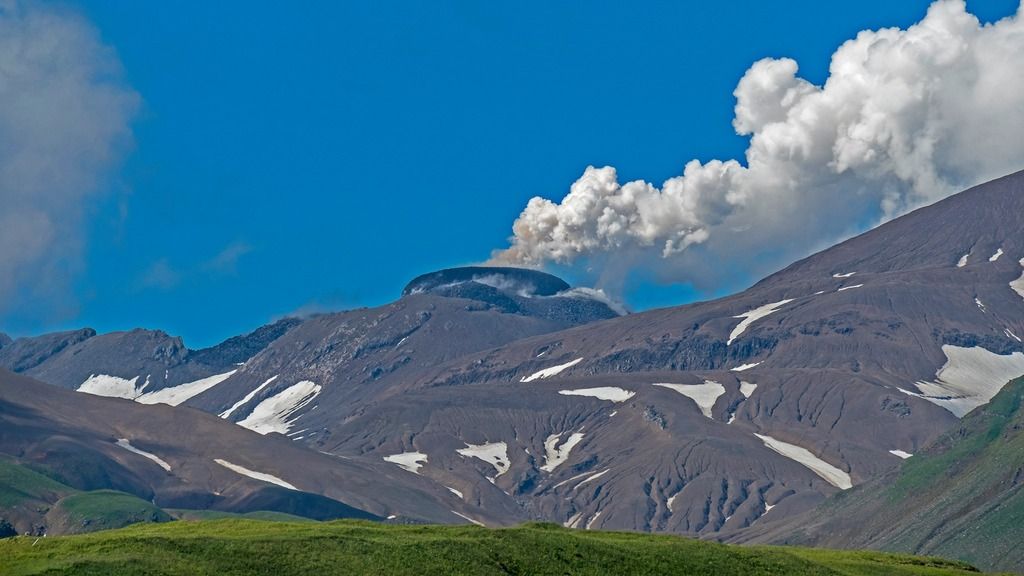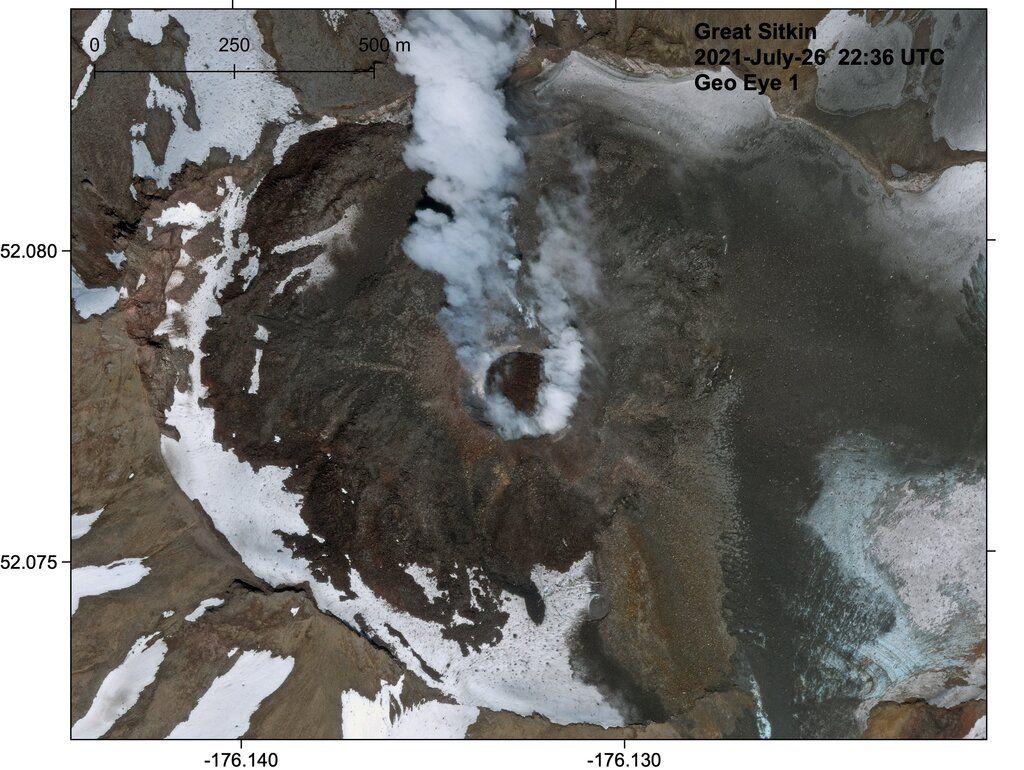So far, none of the small communities near the volcanoes have been affected, Chris Waythomas, a geologist with the Alaska Volcano Observatory, said Thursday.
Webcams on Thursday clearly showed episodic low-level ash emissions from Pavlof Volcano, prompting the observatory to raise the volcano’s threat level from yellow, or exhibiting signs of unrest, to orange, indicating an eruption is underway with minor volcanic ash emissions.
Ash clouds were rising just above the volcano’s 8,261-foot (2,518-meter) summit, drifting about 6 miles (9.7 kilometers) to the south before dissipating, Waythomas said.
Pavlov is a "very sneaky volcano,” Waythomas said. “It can get going without much warning.”
He described the peak as an open system volcano, meaning its “magmatic plumbing system is open and magmas can move to the surface really fast and it can start erupting almost with no warning."
Pavlov is a snow- and ice-covered stratovolcano on the southwestern end of the Alaska Peninsula, nearly 600 miles (965.6 kilometers) southwest of Anchorage.
The nearest community is Cold Bay, about 35 miles (56.33 kilometers) southwest of Pavlov, which is considered one of Alaska’s most active volcanoes in the Aleutian Islands arc of active and dormant volcanoes.
Pavlov last erupted in 2016, dropping some ash on another community, Nelson Lagoon.
The observatory on Thursday received reports from people in the community of Adak of a lava fountain at the summit of the Great Sitkin volcano. The reports were later confirmed by webcam.
“The fact that they just happen to walk outside and see it was really great,” Waythomas said.
He said if activity increases, Adak could get ashfall from Great Sitkin, located on an island about 27 miles (43.45 kilometers) away.
“This lava fountain is kind of unusual for Great Sitkin, but it’s been fairly passive at this point,” he said.
Great Sitkin, a stratovolcano with a caldera and dome, is about 1,150 miles (1,851 kilometers) southwest of Anchorage.
Semisopochnoi Volcano, about 150 miles (241 kilometers) away on an uninhabited island at the western end of the Aleutian Islands, has been erupting intermittently and on Wednesday produced an ash cloud that went to about 10,000 feet (3,048 meters) into the air, Waythomas said.
Mark Thiessen, The Associated Press
Minor volcanic eruptions could ‘cascade’ into global catastrophe, experts argue
Currently, much of the thinking around risks posed by volcanoes follows a simple equation: the bigger the likely eruption, the worse it will be for society and human welfare.
However, a team of experts now argues that too much focus is on the risks of massive yet rare volcanic explosions, while far too little attention is paid to the potential domino effects of moderate eruptions in key parts of the planet.
Researchers led by the University of Cambridge’s Centre for the Study of Existential Risk (CSER) have identified seven “pinch points” where clusters of relatively small but active volcanoes sit alongside vital infrastructure that, if paralyzed, could have catastrophic global consequences.
These regions include volcano groups in Taiwan, North Africa, the North Atlantic, and the northwestern United States. The report is published today in the journal Nature Communications.
“Even a minor eruption in one of the areas we identify could erupt enough ash or generate large enough tremors to disrupt networks that are central to global supply chains and financial systems,” said Dr Lara Mani from CSER, lead author of the latest report.
“At the moment, calculations are too skewed towards giant explosions or nightmare scenarios, when the more likely risks come from moderate events that disable major international communications, trade networks or transport hubs. This is true of earthquakes and extreme weather as well as volcanic eruption.”
Mani and colleagues say that smaller eruptions ranking up to 6 on the “volcanic explosivity index”– rather than the 7s and 8s that tend to occupy catastrophist thinking – could easily produce ash clouds, mudflows and landslides that scupper undersea cables, leading to financial market shutdowns, or devastate crop yields, causing food shortages that lead to political turmoil.
As an example from recent history, the team point to events of 2010 in Iceland, where a magnitude 4 eruption from the Eyjafjallajökull volcano, close to the major “pinch point” of mainland Europe, saw plumes of ash carried on northwesterly winds close European airspace at a cost of US$5 billion to the global economy.
Yet when Mount Pinatubo in the Philippines erupted in 1991, a magnitude 6 eruption some 100 times greater in scale than the Icelandic event, its distance from vital infrastructure meant that overall economic damage was less than a fifth of Eyjafjallajökull. (Pinatubo would have a global economic impact of around US$740 million if it occurred in 2021.)
The seven “pinch point” areas identified by the experts – within which relatively small eruptions could inflict maximum global mayhem – include the volcanic group on the northern tip of Taiwan. Home to one of the largest producers of electronic chips, if this area – along with the Port of Taipei – was indefinitely incapacitated, the global tech industry could grind to a halt.
Another pinch point is the Mediterranean, where legends of the classical world such as Vesuvius and Santorini could induce tsunamis that smash submerged cable networks and seal off the Suez Canal. “We saw what a six-day closure to the Suez Canal did earlier this year, when a single stuck container ship cost up to ten billion dollars a week in global trade,” said Mani.
Eruptions in the US state of Washington in the Pacific Northwest could trigger mudflows and ash clouds that blanket Seattle, shutting down airports and seaports. Scenario modelling for a magnitude 6 eruption from Mount Rainier predicts potential economic losses of more than US$7 trillion over the ensuing five years.
The highly active volcanic centres along the Indonesian archipelago – from Sumatra to Central Java – also line the Strait of Malacca: one of the busiest shipping passages in the world, with 40% of global trade traversing the narrow route each year.
The Luzon Strait in the South China Sea, another key shipping route, is the crux of all the major submerged cabling that connects China, Hong Kong, Taiwan, Japan and South Korea. It is also encircled by the Luzon Volcanic Arc.
The researchers also identify the volcanic region straddling the Chinese-North-Korean border, from which plumes of ash would disrupt the busiest air routes in the east, and point out that a reawakening of Icelandic volcanoes would do the same in the west.
“It’s time to change how we view extreme volcanic risk,” added Mani. “We need to move away from thinking in terms of colossal eruptions destroying the world, as portrayed in Hollywood films. The more probable scenarios involve lower-magnitude eruptions interacting with our societal vulnerabilities and cascading us towards catastrophe.”
JOURNAL
Nature Communications
DOI
10.1038/s41467-021-25021-8
METHOD OF RESEARCH
Commentary/editorial
SUBJECT OF RESEARCH
Not applicable
ARTICLE TITLE
Global catastrophic risk from low magnitude volcanic eruptions
ARTICLE PUBLICATION DATE
5-Aug-2021
Great Sitkin volcano (Aleutian Islands, Alaska):
picture of growing lava dome
Fri, 6 Aug 2021, 09:3009:30 AM | BY: T

Active lava dome of Great Sitkin volcano on 4 Aug 2021 (image: Dave Ward via AVO / facebook)The Alaska Volcano Observatory published a great photo of the active lava dome of the volcano taken a few days ago (see original post on facebook).
It shows the dark mass of fresh viscous lava that has been accumulating on the summit crater since mid July this year, following the re-awakening of the volcano in mid May, when a series of explosions cleared the vent to make way for new magma to reach the surface.
The last explosive event was 25 May 25. Since the arrival of the dome, AVO has been monitoring and using satellite images to measure its rate of growth: It is now over 100m in diameter. At night, Adak residents about 26 miles across the water reported seeing incandescence illuminating the steam plume rising from the dome.
All news about: Great Sitkin volcano
Information about: Great Sitkin volcano
Previous news
Wed, 28 Jul 2021, 03:19
Great Sitkin volcano (Aleutian Islands): new lava dome confirmed

Latest satellite images from 26 July confirmed a new lava dome as reported by the Alaska Volcano Observatory (AVO). ... Read all

No comments:
Post a Comment